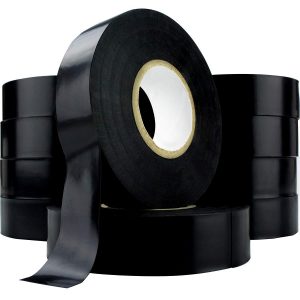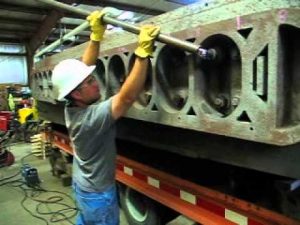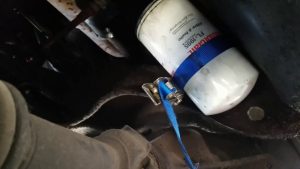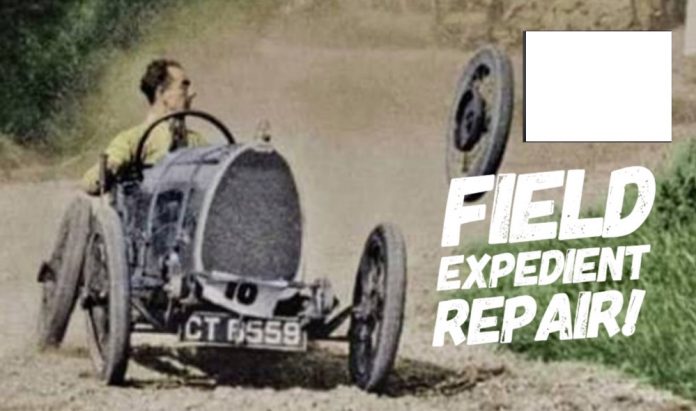Sometimes, you haven’t got the right tool for the job or you haven’t got the time to get the right tool for the job. Maybe because you’re broken down somewhere far from your tools.
What then?
Sometimes, you can make the tool for the job. Or repurpose a tool you have on hand that gets the job done. Necessity being the mother of improvisation.
Vise grip pliers (get a good, pre made-in-China set; the standard jaw and the needle-nose jaw) can loosen bolts and screws when you haven’t got sockets or screwdrivers, remove and install hose clamps and be used to hold things together for just-long-enough. Like a broken battery cable, for instance.
They are the go-too tool for getting damaged screws out when you haven’t got an Easy Out – and back in again when you need to tighten something back up but haven’t got a new, undamaged screw on hand. They can save the day when a bolt head is rounded off and a socket won’t work. They are the American Express card of field expedient tools.
Don’t leave home without one.
Electrical tape is a steady friend – sometimes even more than the better-known silver duct (or “duck”) tape. Electrical tape has expansion/contraction, heat-resistance and leak-keeping attributes that makes it very effective when you need to seal something that’s leaking, like a radiator or heater hose. Wrap it tight – and off you go.
It works on AC (and power steering) pressure hoses, too – voice of experience.
And of course, it’s just the ticket for preventing wires twist-spliced together without benefit of proper connectors from grounding out and leaving you stuck – again. You can also use a piece of electric tape to hold (or just wedge) a loose wire on a connector or contact that can’t can’t be twist-connected back together – for just long enough to get you mobile again.
Ever chip a chrome-plated bolt or lug nut? There are special sockets designed specifically to remove plated sockets and other fasteners without damaging the finish, but you may not have one handy when you need to remove such a bolt. A scrap piece of paper towel can save the day – or at least, save the finish. Put the scrap on the head of the bolt and then ease the socket on top. The piece of scrap paper towel will snug the fit and limit metal-on-metal contact. The bolt should come off without its finish coming off.
Speaking of not coming off . . .
There are times when you have the right socket but insufficient leverage. There are some bolts that not even Franco Columbo could loosen without the help of Archimedes. Air gun-tightened lug nut bolts, for instance.
Which is why it’s a good idea to keep a piece of pipe 2-3 feet long handy. Put that over the handle of your ratchet or tire iron and now you are Franco Colombo! The bolt that seemed unmovable now moves with ease. If you haven’t got the pipe, try the spray. PB Blaster or a similar penetrant, then get a cup of coffee or a beer. When you’re done, tap the bolt with a hammer a little and then try it again. You may not need the bar – or the strength of Franco Columbo!
A piece of wood is also a tool – and can make all the difference. You may already know this if you’ve gotten a flat tire and tried to change it on soft/unpaved ground. You jack the car up but the car goes down as the weight pushes the jack into the ground. If you have a study piece of wood (such as a section of 2×6) to put under the jack,you’ll be able to jack the car up instead of the jack down. The wood can also extend the lifting range of the jack, providing the clearance you might not otherwise get. The same piece of wood can also get you traction – as by shoving it under the wheel that’s spinning on packed snow that’s not letting you go.
Speaking of hardware-store stuff, keeping some rough-hewn rope handy is often . . . handy. It can be used to get a stubborn oil filter off when an oil filter wrench fails. Wrap the rope around the filter nice and tight, leaving enough on either end to let you pull on the one end while holding the other, to maintain tension. Off comes the filter – without having to make a run to the parts store.
A ratcheting tie down works, too.
Rope also comes in handy when you need to hold down a liftgate that won’t stay closed or which you can’t close it because of something in the cargo area that prevents it.
But perhaps the most important field expedient tool is the one between your ears. Think before you improvise and be careful about improvising. It is sometimes better to accept having to make a trip to the store to get the right tool than to use the wrong tool wrongly – and end up with a problem worse than the one you started with!
. . .
Got a question about cars, Libertarian politics – or anything else? Click on the “ask Eric” link and send ’em in!
If you like what you’ve found here please consider supporting EPautos.
We depend on you to keep the wheels turning!
Our donate button is here.
If you prefer not to use PayPal, our mailing address is:
EPautos
721 Hummingbird Lane SE
Copper Hill, VA 24079
PS: Get an EPautos magnet or sticker or coaster in return for a $20 or more one-time donation or a $10 or more monthly recurring donation. (Please be sure to tell us you want a magnet or sticker or coaster – and also, provide an address, so we know where to mail the thing!)
My eBook about car buying (new and used) is also available for your favorite price – free! Click here. If that fails, email me at [email protected] and I will send you a copy directly!












I had a flat, in my driveway, when it was 10 degrees F. I had the tire off a few months prior, I don’t know what the ice did to the rust, but for the life of me (after I removed the lug nuts I hand tightened a few months ago) I couldn’t get that wheel to let go and come off.
I went to use a propane torch, either the bottle value wasn’t working due to the cold, or there’s something wrong with my torch nozzle. So, I used an electric heat gun using a circular motion. The wheel finally came off, but it left me wondering what I should pack for the next time? I’m not sure a lubricate of any kind could get behind the wheel. Anyone have experience with that?
If it ever happens on the road, I wonder if it’s a really bad idea to thread the lug nuts on a few turns and then drive slowly to try and break the wheel free?
A couple electrical clip leads, and a length of 12 or 14 AWG stranded, with some crimp-on butt splices, and a couple crimp-on spade males and females. The needle-nose vice grips will do a decent job crimping. Can’t tell you how many times having a little wire and a way to connect it has save my tuchas.
A cheap throw-down voltohmmeter for checking the battery, etc. is very useful too.
Any ideas for an oxygen sensor in the exhaust manifold? I tried the leverage of a 3′ steel bar. Maybe a blow torch, I’ve heard?
Good morning, BaDnOn!
I’ve dealt with stuck 02 sensors so ah feel your pain. Have you tried the PV Blaster – and let it soak overnight?
Eric,
Can’t say I’ve heard of PV Blaster, but I’ll certainly give it shot! Looks like there are many suggestions, so I’ll parse through them first.
BaDnOn,
It’s actually called PB Blaster, not PV.
Living in a salty, rust promoting area, I’ll vouch for PB Blaster. It gets things unstuck that you wouldn’t believe. I just wish they had the “straw” dispenser thingy like WD-40 (a good product in its own right for certain applications but not as good as the blaster… less long lived as well).
If you try these “hot” methods, do tell as to the results. Sounds like a real adventure…
Get out the heat wrench and sacrifice a goat to the O2 sensor gods.
Best bet is to unscrew only while the bung is glowing hot.
The problem with PB blaster is that the sensor has a sealing washer and the fluid won’t make it far. may not be comfortable, but get the exhaust hot. Whatever you are using, make sure it’s a six point. Sometimes you can bust of the electrical connector and use a normal six point socket. If you have room, you might be able to get an impact wrench on it. If so give it a few raps in each direction. If not, see if you can get a box end wrench on. (Six point is still a must) and hit the other end with a hammer. They usually only need to move very little before they break free. If you can’t fit a box end wrench, use one of this style O2 Sensor sockets.
https://www.harborfreight.com/3-8-eighth-inch-offset-oxygen-sensor-wrench-97177.html
You can get them many places. Now that the deepwell with the slot cut into it is worthless.
Heat. Maybe propane torch grade will work, maybe pseudo-MAPP, but sometimes only an oxy/acetylene gas axe will heat it enough to break the rust loose. Try a propane torch first, likedirtybob above said, attempt removal while hot. A cheater on a breaker bar will usually be enough if the rust is not too bad.
If the sensor is hard to turn, add more heat or you run an increased risk of galling the threads. Again, best results are achieved when the metal is glowing red hot. It’s not much fun trying to repair/replace a damaged bung in a cast manifold (assuming this is the case with BaDnOn).
I work on rusty old crap far too often and sometimes nothing works…
Here’s a pic of your car after a few decades in Iowa: https://www.hotrodders.com/attachments/rear-end-jpg.440537/
The idea is to shock it with water when it’s hot. that busts the rust bond. The water cools it down so you don’t have to worry about messing up the threads.
Uh, is that actually a differential? A curiously shaped petrified tree or other rock formation?
For anything exhaust what works the best for me is my fake MAPP gas torch. Heat until red then I spray water on it from an old spray bottle. Then with a cordless impact it comes free. I can’t recall if I resorted to that with an O2 sensor or not. I may have on the front pipe for the mazda. I think I unplugged sensor when I removed the pipe and then used the heat and quench method on it or something to get it free off the car. I don’t have an O2 socket so I know I didn’t use an impact on it.
Brent and everyone who made suggestions,
Thanks! Sounds like it will be a fun and exciting job. :p
Hopefully I can keep from damaging the threads. I don’t want to change out the exhaust as well.
I have an MTD ride on mid 90s vintage. There is a spring running from the deck to a frame connection. The spring is quite strong, so much so that I could not stretch to the proper length to put it back on. My son showed me how to do attach the spring with a small ratchet strap. Worked great. Neat way to save a lot of work and swearing.
A Leatherman multi-tool, I prefer the Wave model, has been useful on many occasions. I keep one in the glovebox.
I used a Leatherman quite a bit when I moved, saved me some time. Been carrying it ever since. Howevah; I can’t stand the grips when using the pliers when I need to grip them really hard, the handles painfully bite into my fingers and palms. Perhaps there’s a model I’m unaware of that isn’t like mine? As a result, I never rely on them as pliers, yet do have a pair in the glovebox, too.
Stuck bolts can sometimes be loosened by whacking on the back of the screw/nut driver with a mallet or other suitable whacking device while applying counter-clockwise tension. Should only take one or two hits. Think impact wrench without the power assist.
PB Blaster has my endorsement. It’s the best.
Everybody should have some baling wire or fencing wire on hand. I bought a quarter mile spool for $15 years ago. With some baling wire and linesman pliers you can make some field repairs that’ll keep broken parts from flapping in the breeze. It’s got me home with busted exhausts, cracked leaf springs, cables and lines rusting off mounts and dangling. Also works great for bushcraft lashing logs together for sturdy shelters. Keep a small bundle in your trunk, it’ll come in handy some day.
chain vise grips come in handy for a number of jobs.
https://www.northerntool.com/images/product/2000×2000/152/15233_2000x2000.jpg
using a hammer on the end of a wrench or ratchet handle makes an improvised impact and is much more compact than a cheater bar (plus significantly less likely to break the fastener).
FWIW I have never had any luck with penetrating oils for disassembly (rust belt). A torch (even the little mapp gas ones) does it better.
Use them in combination. The hot part will suck the penetrating fluid in. Also, they’re not all created equal. PB blaster pretty much rules as the commercially available product. Many people also swear by a 50/50 mix of ATF and acetone. I’ve never used it personally, but there’s many videos about it. If I ever have a really small rusty fastener that I know is likely to break off, I will put the car somewhere accessible but out of the way. Then spray the area regularly for approximately every hour, for as long as I can. Usually the pb blaster will disolve enough of the rust to prevent breakage.
…and for SAAAAFFFTTYYYYY… (MY call, MY insurance)… the fire extinguisher has saved my ass 4 times on the road over the years…
Add zip ties.
Gotta love ’em.
https://www.amazon.com/gp/product/B08K8FNGV8
They are handy. Just don’t get caught with them in DC- they’re a tool of insurrection there I hear…